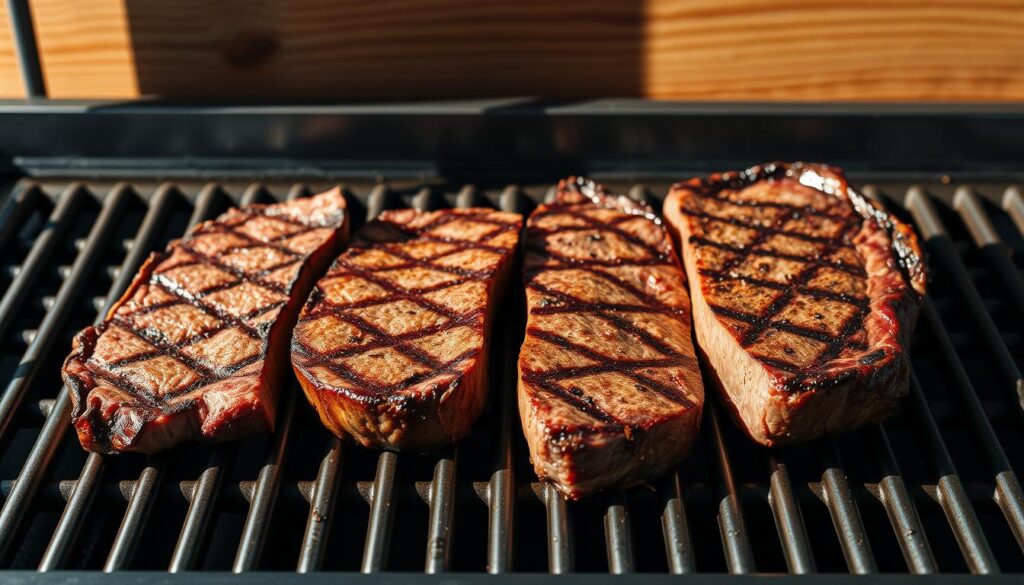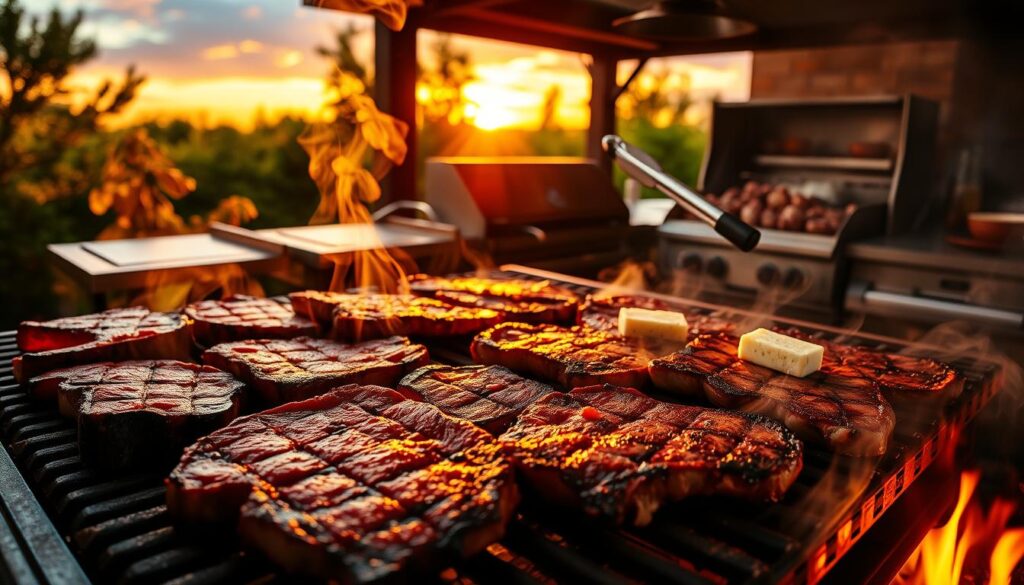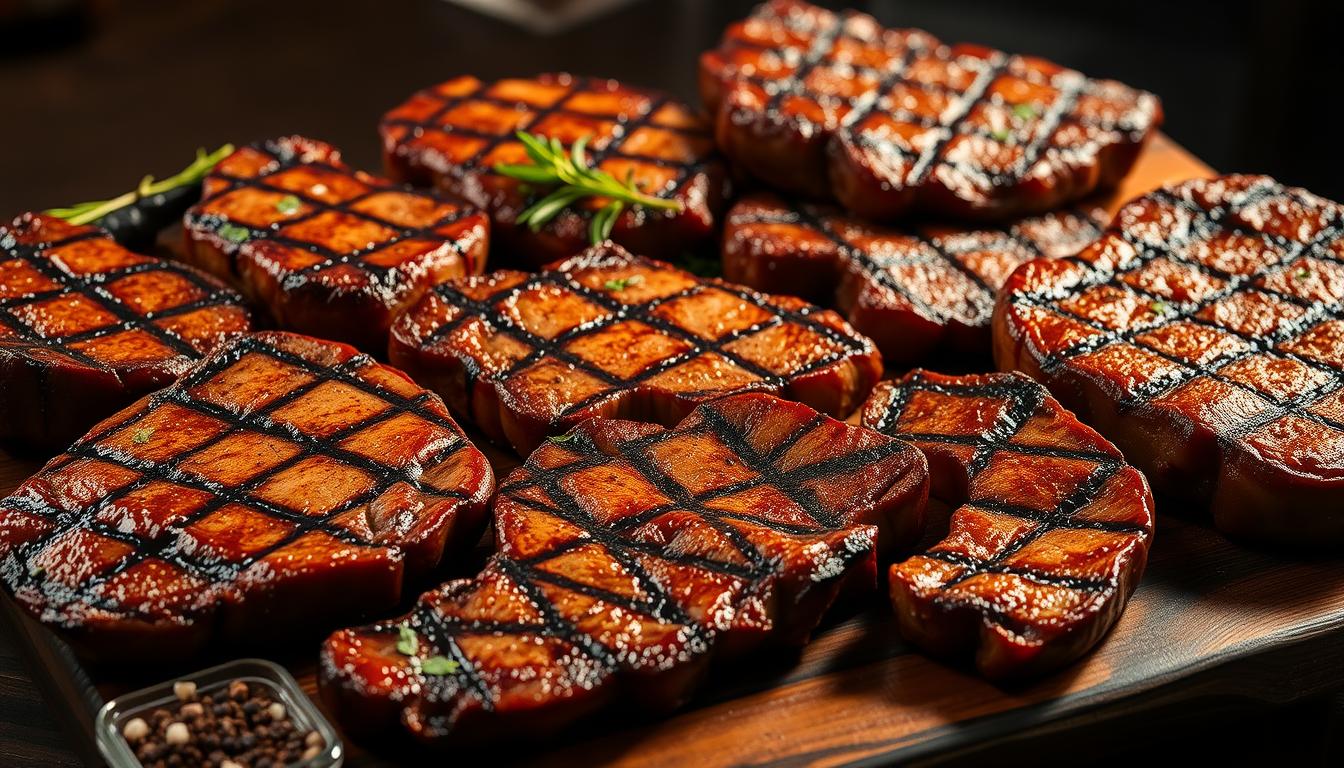Summer is here, and the smell of steaks grilling fills the air. It’s a magical time for backyard cooking. Choosing the right steak can make your BBQ unforgettable.
It’s not just about picking any meat. It’s about knowing the best cuts for flavor and tenderness. Whether you grill often or just on weekends, the right steak can make your BBQ stand out.
We’ll show you seven amazing steak cuts for your next BBQ. You’ll learn about affordable and premium options. Discover how to pick, prepare, and grill steaks that everyone will love.
Get ready to master the art of grilling. Your outdoor cooking will become a true culinary adventure. Start your journey to becoming a steak grilling expert today.
Understanding Premium Cuts vs Budget-Friendly Options
Exploring your grilling steaks guide can change your barbecue game. Not all steaks are the same, and you don’t have to spend a lot to enjoy a great meal.
Choosing the right steak cut is key to grilling success. We’ll guide you through the steak world, helping you pick wisely.
Why Premium Cuts Command Higher Prices
Premium steaks are pricier for several reasons:
- Tenderness of the meat
- Marbling quality
- Location of the cut on the cow
- Overall meat quality
Value Alternatives for Every Budget
Even on a tight budget, you can grill amazing steaks. Here are some affordable choices:
| Cut | Average Price | Flavor Profile |
|---|---|---|
| Flat Iron | $8-$12/lb | Rich, beefy flavor |
| Chuck Eye | $6-$10/lb | Tender with good marbling |
| Sirloin Tip | $5-$9/lb | Lean and versatile |
The Role of Marbling in Steak Selection
Marbling, or the white fat in meat, is key for flavor and tenderness. More marbling means a juicier, tastier steak. Look for meat with fine, consistent marbling.
With this knowledge, you’ll grill like a pro, making delicious meals without spending a lot.
Essential Tools and Equipment for Grilling Steaks
Mastering the art of grilling steaks is more than just having great meat. The right tools can turn your backyard barbecue into a pro-level event. Start your steak grilling journey with quality equipment that ensures both precision and flavor.
Every serious griller needs a core set of essential tools. Here are the must-have items for your grilling arsenal:
- High-quality meat thermometer for precise temperature control
- Long-handled stainless steel tongs
- Heavy-duty grill brush
- Cast iron grill grates
- Sturdy grilling gloves
Choosing the right grill is key for steak grilling tips. Gas grills offer consistent heat, while charcoal grills give that classic smoky flavor. Think about your cooking style and space when picking your grill.
For ultimate grilling steaks, invest in specialized equipment that takes your cooking to the next level:
- Digital instant-read thermometer
- Meat claws for handling and shredding
- Grill basket for smaller cuts
- Meat injector for marinades
Pro grillers know that keeping your tools in top shape is crucial. Clean your grill grates after each use and check your equipment regularly for wear and tear.
Remember: Great equipment doesn’t guarantee perfect steaks, but it certainly improves your chances of grilling success!
The Ultimate Guide to Steaks for Grilling
Choosing the right steak can make your grilling experience amazing. Knowing about different cuts is key for great grilled steak ideas. These will impress your guests and please your taste buds.
Not all steaks are the same. Each cut has its own special qualities. They offer different textures, flavors, and cooking experiences. Let’s explore three top steak options to boost your barbecue skills.
Ribeye: The King of Marbling
Ribeye is a top choice for steak lovers. It’s known for its rich marbling, making it incredibly juicy and flavorful. The fat in the meat makes it tender and delicious.
- Best suited for high-heat grilling
- Ideal internal temperature: 130-135°F for medium-rare
- Recommended cooking time: 4-5 minutes per side
Strip Steak: The Versatile Classic
Strip steak is a great mix of tenderness and beef flavor. It’s a favorite among chefs and home grillers. Its quality and easy preparation make it perfect for grilled steak ideas.
| Characteristic | Strip Steak Details |
|---|---|
| Fat Content | Moderate marbling |
| Ideal Thickness | 1-1.5 inches |
| Recommended Seasoning | Kosher salt and black pepper |
Flat Iron: The Budget-Friendly Champion
Flat iron steak is a great choice for those on a budget. It’s cut from the shoulder and offers great taste and tenderness. It’s also more affordable than other cuts.
- Trim excess connective tissue
- Season generously
- Grill over medium-high heat
- Rest for 5-7 minutes after cooking
Learning about these three cuts will help you make amazing steaks at home. Remember, the best grilled steaks come from choosing the right cut and perfecting your grilling technique.
Mastering Temperature Control for Perfect Steaks
Cooking steaks on the grill needs precision and heat management skills. The key to great steaks is controlling the temperature and getting perfect grill marks. These marks seal in the flavor.
To cook steaks well, start by heating your grill to the right temperature. Different doneness levels need specific heat:
- Rare steaks: 125°F internal temperature
- Medium-rare: 135°F for ideal tenderness
- Medium: 145°F with slight pink center
- Well-done: 160°F and above
For perfect grill marks, follow these tips:
- Clean and oil your grill grates before cooking
- Ensure grill is heated to high temperature (around 450-500°F)
- Place steak at a 45-degree angle to grate lines
- Cook for 2-3 minutes before rotating 90 degrees
Always use a meat thermometer to check the internal temperature. After grilling, let your steak rest for 5-10 minutes. This step lets juices spread, making the steak juicy and flavorful.
Pro tip: Direct heat creates those impressive grill marks, while indirect heat helps cook the steak evenly without burning.
Marinades, Rubs, and Seasonings for Enhanced Flavor
Grilling steaks is more than just throwing meat on the grill. The right seasonings can turn an ordinary steak into a mouthwatering dish. It will impress your guests and make your taste buds happy.
Seasoning is an art that can greatly enhance your grilled meats’ flavor. Learning about marinades, dry rubs, and seasonings will help you make steaks that taste like they’re from a restaurant. You can do it all in your backyard.
Dry Rub Combinations
Creating the perfect dry rub can unlock incredible flavors for your steaks. Here are some winning combinations:
- Classic BBQ Rub: Paprika, brown sugar, garlic powder, salt, and black pepper
- Southwestern Blend: Cumin, chili powder, smoked paprika, oregano
- Herb-Infused Mix: Dried thyme, rosemary, sage, with cracked black pepper
Marinade Recipes for Tough Cuts
Tougher cuts of meat really benefit from marinades. Acidic ingredients help break down muscle fibers. This makes your steaks tender and full of flavor.
“A good marinade can turn an affordable cut into a memorable meal.” – Grilling Experts
When to Season Your Steaks
Timing is key when seasoning steaks for grilling. For dry rubs, apply 30-60 minutes before cooking. This lets flavors sink in. Marinades work best 2-8 hours before grilling, depending on the meat’s thickness and tenderness.
- Quick marinades: 30 minutes for thin cuts
- Complex marinades: 4-8 hours for tougher steaks
- Avoid marinating too long to prevent meat from becoming mushy
Pro tip: Always pat your steaks dry before applying seasonings. This ensures a good brown crust and crisp exterior when grilling.
The Art of Grilling Different Steak Thicknesses

Grilling steaks is an art that depends on thickness. Your guide should note that thickness changes how heat spreads and the final taste. Choosing the right method for each steak ensures a great meal every time.
When looking at steak grilling tips, remember these key thickness guidelines:
- Thin Steaks (Under 1 inch): Quick, high-heat cooking
- Medium Steaks (1-1.5 inches): Moderate direct and indirect heat
- Thick Steaks (Over 1.5 inches): Reverse searing recommended
Grilling thick steaks needs extra care. Start by letting your steak warm up to room temperature. Thick cuts need slow, controlled cooking. This way, they get to the perfect inside without burning the outside.
The secret to restaurant-quality steaks lies in understanding heat management across different thicknesses.
To get the best results, use a reliable meat thermometer. It helps you get the exact doneness, turning your backyard BBQ into a gourmet feast.
Using Butter to Elevate Your Grilled Steaks
Turning your grilled steaks into something special often depends on one key ingredient: butter. This simple addition can make your steak taste like it’s from a fancy restaurant. The right way to use butter can make your steak taste richer, look more luxurious, and improve your grilling skills.
Butter is more than just a topping; it’s a flavor booster. When used right, it adds depth, makes the steak look shiny, and brings out new flavors.
Crafting Compound Butter Recipes
Compound butters can take your grilled steaks to new heights. Here are some tasty options:
- Herb-Infused Butter: Mix softened butter with fresh herbs like rosemary, thyme, and parsley
- Garlic Parmesan Butter: Blend butter with minced garlic and grated Parmesan cheese
- Smoky Chipotle Butter: Add chipotle peppers for a spicy touch
Mastering Butter Application Timing
When to add butter to your steak is key. Here’s the best way to do it:
- Grill your steak until it’s 10-15 degrees below your final temperature
- Take it off the heat
- Add a pat of compound butter
- Let the butter melt and create a rich, glossy coating
For the best results, use clarified butter or ghee for high-heat grilling. It prevents burning and gives a perfect golden crust.
Advanced Grilling Techniques for Restaurant-Quality Results

To turn your backyard BBQ into a pro-level grilling session, you need to learn advanced techniques. For the best grilling steaks, knowing how to cook with precision is key. This can take your meat game from good to amazing.
Experts use several important techniques to get perfect grill marks and top-notch results:
- Reverse Searing Method
- Precise Temperature Control
- Strategic Meat Probe Placement
- Zone Grilling Techniques
The reverse searing method cooks your steak evenly. You start at a low temperature and finish with a high-heat sear. This way, you get a consistent inside and a tasty crust on the outside.
| Technique | Temperature Range | Recommended Use |
|---|---|---|
| Reverse Sear | 225-250°F (initial) | Thick cuts over 1.5 inches |
| Direct Searing | 450-500°F | Thinner steaks |
| Zone Grilling | Two-temperature zones | Varied thickness cuts |
Getting a good meat probe is a game-changer for grilling. It lets you check the internal temperature precisely. This way, you can cook your steak just right, without overcooking it.
Pro tip: Let your steak rest for 5-10 minutes after grilling. This lets the juices spread out, making it more flavorful and tender.
Remember, the more you practice, the better you’ll get at grilling steaks. Try out different techniques and see how they affect your steak. This will help you find what works best for you.
Common Grilling Mistakes to Avoid
Learning to grill steaks is more than just throwing meat on hot coals. Even skilled grillers can make mistakes that ruin a steak. These errors can turn a tasty steak into a bad meal.
To grill steaks perfectly, you need to know and avoid common mistakes. These mistakes can ruin your cooking.
Temperature Management Errors
Keeping the right temperature is key when grilling steaks. Many home cooks make big mistakes:
- Using high heat for the whole cooking time
- Not preheating the grill right
- Not setting up different heat zones
“A great steak begins with understanding your grill’s temperature zones.” – Grill Master Chef
Resting Time Miscalculations
Resting your steak after grilling is crucial. Cutting into a steak too soon lets juices run out. This makes the steak dry and tough.
- Let thick steaks rest 5-10 minutes
- Smaller cuts need at least 3-5 minutes
- Cover with aluminum foil during resting
Seasoning Mistakes
Seasoning is key for a great grilled steak. Avoid these common errors:
- Over-salting before cooking
- Using stale or low-quality seasonings
- Applying marinades too early
By avoiding these grilling mistakes, you’ll improve your steak grilling. You’ll get delicious results every time you grill.
How to Choose the Best Cut for Your Grilling Style
Choosing the right steak for grilling is all about knowing what you like and how well you can cook. The best steaks for grilling can make your barbecue experience truly special.
When picking steaks for grilling, keep these important factors in mind:
- Marbling quality
- Cut thickness
- Personal flavor preferences
- Cooking technique
- Budget constraints
Your grilling style is key in picking the right cut. Novice grillers might want easier cuts, while seasoned chefs can handle more complex ones.
| Grilling Skill Level | Recommended Steak Cut | Difficulty |
|---|---|---|
| Beginner | Flat Iron | Easy |
| Intermediate | Strip Steak | Medium |
| Advanced | Ribeye | Challenging |
Knowing your cooking gear, temperature control, and desired doneness helps pick the perfect steak. Remember, grilling gets better with practice.
Pro tip: Always choose steaks with consistent marbling for the most flavorful and tender results.
Conclusion
Your journey through the ultimate grilling steaks guide has given you key knowledge. You now know how to make ordinary backyard cookouts into amazing meals. You’ve learned about premium cuts and advanced techniques to grill steaks like a pro.
Choosing the right cut is just the start of your grilling journey. Ribeye, strip steak, and flat iron each offer unique flavors. By using the right temperature control, seasoning, and flavor tips, you can make every steak exceptional.
Great grilling is about passion, practice, and learning more. Try different cuts, marinades, and grilling methods. As you get better, you’ll become a backyard grill master, impressing everyone with your meals.
Whether you’re new to grilling or already skilled, this guide has given you the tools to improve. Embrace the journey, trust your instincts, and enjoy the delicious results of your hard work.

